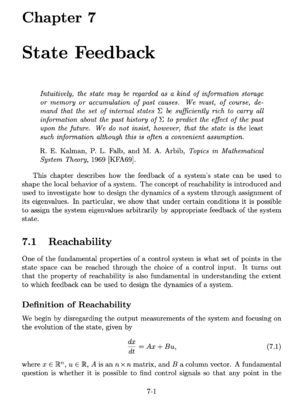Difference between revisions of "State Feedback"
| (3 intermediate revisions by the same user not shown) | |||
| Line 1: | Line 1: | ||
{{Chapter | {{Chapter | ||
|Chapter number=7 | |Chapter number=7 | ||
| + | |Short name=statefbk | ||
|Previous chapter=Linear Systems | |Previous chapter=Linear Systems | ||
|Next chapter=Output Feedback | |Next chapter=Output Feedback | ||
| + | |First edition URL=https://www.cds.caltech.edu/~murray/amwiki/index.php?title=State_Feedback#Additional_Exercises | ||
|Chapter summary=This chapter describes how feedback can be used to shape the local behavior of a system. The concept of reachability is introduced and used to investigate how to "design" the dynamics of a system through placement of its eigenvalues. In particular, it will be shown that under certain conditions it is possible to assign the system eigenvalues to arbitrary values by appropriate feedback of the system state. | |Chapter summary=This chapter describes how feedback can be used to shape the local behavior of a system. The concept of reachability is introduced and used to investigate how to "design" the dynamics of a system through placement of its eigenvalues. In particular, it will be shown that under certain conditions it is possible to assign the system eigenvalues to arbitrary values by appropriate feedback of the system state. | ||
|Chapter contents=# Observability | |Chapter contents=# Observability | ||
| Line 28: | Line 30: | ||
}} | }} | ||
== Chapter Summary == | == Chapter Summary == | ||
| − | |||
<ol> | <ol> | ||
<li> <p> A linear system with dynamics | <li> <p> A linear system with dynamics | ||
Latest revision as of 13:27, 7 April 2024
| Prev: Linear Systems | Chapter 7 - State Feedback | Next: Output Feedback |
This chapter describes how feedback can be used to shape the local behavior of a system. The concept of reachability is introduced and used to investigate how to "design" the dynamics of a system through placement of its eigenvalues. In particular, it will be shown that under certain conditions it is possible to assign the system eigenvalues to arbitrary values by appropriate feedback of the system state.
Chapter Summary
-
A linear system with dynamics
is said to be reachable if we can find an input defined on the interval that can steer the system from a given final point to a desired final point .
The reachability matrix for a linear system is given by
A linear system is reachable if and only if the reachability matrix is invertible (assuming a single intput/single output system). Systems that are not reachable have states that are constrained to have a fixed relationship with each other.
A linear system of the form
is said to be in reachable canonical form. A system in this form is always reachable and has a characteristic polynomial given by
A reachable linear system can be transformed into reachable canonical form through the use of a coordinate transformation .
A state feedback law has the form
where is the reference value for the output. The closed loop dynamics for the system are given by
The stability of the system is determined by the stability of the matrix . The equilibrium point and steady state output (assuming the systems is stable) are given by
Choosing as
gives . If a system is reachable, then there exists a feedback law of the form
the gives a closed loop system with an arbitrary characteristic polynomial. Hence the eigenvalues of a reachable linear system can be placed arbitrarily through the use of an appropriate feedback control law.
Integral feedback can be used to provide zero steady state error instead of careful calibration of the gain . An integral feedback controller has the form
where
is the integral error. The gains , and can be found by designing a stabilizing state feedback for the system dynamics augmented by the integrator dynamics.
A linear quadratic regulator minimizes the cost function
The solution to the LQR problem is given by a linear control law of the form
where is a positive definite, symmetric matrix that satisfies the equation
This equation is called the algebraic Riccati equation and can be solved numerically.
Teaching MaterialsNone available Additional ExercisesNone available Frequently Asked QuestionsNone available Errata |
Python CodeThe following Python scripts are available for producing figures that appear in this chapter. See the software page for more information on how to run these scripts. Additional Information |



![{\displaystyle [0,T]}](https://en.wikipedia.org/api/rest_v1/media/math/render/svg/35ccef2d3dc751e081375d51c111709d8a1d7ac6)


![{\displaystyle W_{r}=\left[{\begin{matrix}B&AB&\cdots &A^{n-1}B\end{matrix}}\right].}](https://en.wikipedia.org/api/rest_v1/media/math/render/svg/7ae44ec1a7adc515510850c5ca5f1591cc426bba)

![{\displaystyle {\frac {dz}{dt}}=\left[{\begin{matrix}-a_{1}&-a_{2}&-a_{3}&\dots &-a_{n}\\1&0&0&\dots &0\\0&1&0&\dots &0\\\vdots &&\ddots &\ddots &\vdots \\0&&&1&0\\\end{matrix}}\right]z+\left[{\begin{matrix}1\\0\\0\\\vdots \\0\end{matrix}}\right]u}](https://en.wikipedia.org/api/rest_v1/media/math/render/svg/8fd93c407ea3222940d2b542dc7c9320c18c2e0e)


















